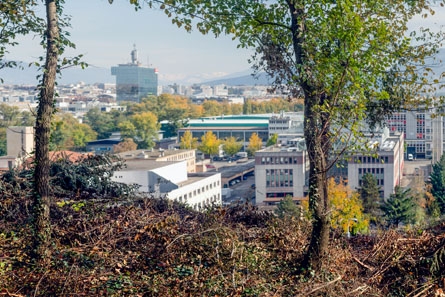Some 1,300 young trees will be planted in the beech wood in Parc La Grange between the end of the winter and autumn 2021. Work will also be carried out to secure the rock outcrops, clear the land and redevelop the pathways in Bois de la Bâtie, where 1,500 young trees have already been replanted.
The Parks and Gardens Department is currently working on two major regeneration projects in wooded and forest areas. The first involves the regeneration of the beech wood in Parc La Grange, with 1,300 young trees being planted in the wooded area near Route de Frontenex between March and autumn 2021. The second project involves clearing and securing the rock outcrops in Bois de la Bâtie, where 1,500 young trees have already been replanted, and redeveloping the pathways which have been closed for the past 2 years.
Particular attention must be paid to our urban forests and wooded areas, which are already subject to considerable pressure due to pollution, climate change and a high number of visitors. According to Alfonso Gomez, Administrative Councillor responsible for the Department of Finance, Housing and the Environment, “The 70 hectares of urban forest and 40,000 trees located outside the forests within the municipal territory are a living and breathing lung that must be protected and developed by means of creative solutions. They play an essential role in adapting to and combating climate change while improving the quality of the air and the well-being of the local inhabitants.”
Regeneration of the beech wood in Parc La Grange
Already affected by successive droughts in recent years, the beech wood in Parc La Grange paid a heavy toll during the storm of 13 August 2020. To remedy this, some 1,300 young trees, more resistant to heat, will be planted between March and autumn of this year.
To ensure the best possible regeneration of this wooded area, the ten different species have been selected for their ability to adapt to global warming. Siberian elms, Cappadocian maples, Oriental beeches and hornbeams or Persian ironwoods will transform the current beech wood into a wooded area reminiscent of the forests on the shores of the Caspian Sea, with its climate similar to that which will be typical of Geneva in the future. The species have also been chosen for their landscaping qualities, and in particular their flamboyant autumn colours. Most of these species of tree can already be found in Geneva, albeit planted individually in parks or along streets.
The new approach taken here involves bringing these species together in more densely-planted forests. The Parks and Gardens Department will monitor their growth, thinning them out and regulating competition between trees where necessary to ensure optimum development of the area as a whole so that it will present an ideal picture in about fifteen years’ time. The old beech trees already present will be maintained and protected for as long as possible. Old trees and new species will rub shoulders, seamlessly creating a new landscape in Parc La Grange.
Regeneration of the forest in Bois de la Bâtie and work to secure the rock outcrops
As part of its redevelopment project, the Bois de la Bâtie – already subject to considerable pressure due to the combined effects of global warming and a high number of visitors – is also the focus of an extensive regeneration project.
Twenty six trees (cherry trees, lime trees, oaks and maples) and some 1,500 forest seedlings have already been planted. The former now embellish the recently renovated pathway, in particular around the three belvederes and the refreshments stand. The 1,500 forest seedlings will primarily grow at forks in the paths with the long-term aim of creating wooded borders conducive to the biodiversity of flora and fauna.
To ensure the security of the rock outcrops in the largest forest within the municipal territory, essential work to secure and clear the area will be launched on 22 February. The work will allow the pathways winding up the escarpment overlooking the Arve to be re-opened in July, a welcome initiative as they are greatly appreciated by the local population and have been closed for 2 years. These paths were closed following a security inspection which revealed the dangers inherent to the site. The geological situation is similar to the Saint-Jean escarpment standing opposite, where rock slides have just occurred causing the path there to be closed. The weight of the large trees combined with the fragility of the soil and rocks destabilises the rock face, leading to landslides. Some 1,700 m² of the 200,000 m² of land in the Bois de la Bâtie will be cleared, with 37 trees having to the felled. The forest will then be regenerated either naturally or artificially, depending on the state of the land.
The work required to stabilise the sector and allow visitors once again to enjoy the site will be carried out in two stages:
- from February to April 2021: clearing, removal of almost 1,200 m3 of rubble and work to secure the rock outcrop.
- from May to July 2021: redevelopment of the pathways
The branches from the trees felled will be used on site to build a rubble removal corridor, thereby channelling any rocks which might fall during the demolition of the overhangs and protecting the ground. The tree trunks, in particular of the oaks, will be recovered and recycled as beams and planks to be used in the City as required by the different departments.
Within the framework of its forest management plan 2013-2024, approved by the State Council in January 2015, the City of Geneva undertakes to make its forests sustainable and to promote their different functions such as maintaining and developing biodiversity, protecting the landscape or welcoming the population in the best possible conditions. Appropriate maintenance is the best means of ensuring they enjoy a long life.
Contact
Service des espaces verts
118 Rue de Lausanne
1202
Genève
Entrée des véhicules: 120 rue de Lausanne
Article modifié le 21.08.2023 à 09:01

